Effect of Mg Addition on Inclusions in the Welding Heat-Affected Zone of Pressure Vessel Steels
Abstract
:1. Introduction
2. Materials and Methods
3. Results
3.1. Inclusions of the Experimental Steel in the Welding HAZ
3.2. EDS Analysis of the Main Inclusion Composition
4. Discussion
4.1. The Effect of Adding Mg on the Welding HAZ of Experimental Steels
4.2. The Mechanism of IAF Nucleation Induced by Mg Elements in the Welding HAZ
4.2.1. IAF Nucleation Mechanism Induced via minimum Lattice Mismatch
4.2.2. IAF Nucleation Mechanism Induced via Stress-Strain Energy
4.2.3. IAF Nucleation Mechanism Induced via Local Compositional Change
4.2.4. IAF Nucleation Mechanism Induced via Inert Interface Energy
5. Conclusions
- (1)
- With increasing Mg content, the number density of the total inclusions and the number density of the effective inclusions in the experimental steel welding HAZ show an upward trend. The total number density of the inclusions and the number of effective density inclusions in the welding HAZ of the experimental steel without added Mg are the lowest, with 132 pieces/mm2 and 122 pieces/mm2, respectively. In contrast, the welding HAZ of the experimental steel with 5 wt.% Mg added exhibits the highest total number density of inclusions and the number density of effective inclusions, amounting to 656.39 pieces/mm2 and 579.10 pieces/mm2, respectively.
- (2)
- In the three experimental steels with Mg elements, the number density of the inclusions that play the role of pinning and inducing IAF nucleation increases gradually and is markedly higher than that of the R steel. The addition of Mg elements is beneficial to produce more inclusions inducing IAF nucleation in the welding HAZ of the experimental steel under the experimental conditions.
- (3)
- The inclusions in the experimental steel welding HAZ with Mg elements are mainly elliptical composite inclusions composed of (Mg-Zr-O) + MnS with a very small size of approximately 1.5 μm. The inclusions with such shape and size are conducive to the nucleation and growth of ductile IAF microstructures.
- (4)
- After the addition of Mg elements, MnS is precipitated on the surface of Mg-containing inclusions in the welding HAZ. IAF nucleation is induced mainly via a minimum lattice mismatch mechanism, supplemented by stress-strain energy and inert interface energy mechanisms.
Author Contributions
Funding
Institutional Review Board Statement
Informed Consent Statement
Data Availability Statement
Acknowledgments
Conflicts of Interest
References
- Čapek, J.; Trojan, K.; Kec, J.; Černý, I.; Ganev, N.; Němeček, S. On the Weldability of thick P355NL1 pressure vessel steel plates using laser welding. Materials 2020, 14, 131. [Google Scholar] [CrossRef] [PubMed]
- Azeem, M.; Ya, H.H.; Alam, M.A.; Kumar, M.; Stabla, P.; Smolnicki, M.; Gemi, L.; Khan, R.; Ahmed, T.; Ma, Q. Application of filament winding technology in composite pressure vessels and challenges: A review. J. Energy Storage 2022, 49, 103468. [Google Scholar] [CrossRef]
- Fu, Z.; Fu, Z.; Li, T.; Mei, M.; Gou, G.; Zhu, Z.; Ma, C.; Gao, W.; Hu, Y. HISCC behavior of SUS301L-MT stainless steel laser-arc hybrid welding joints. Int. J. Mod. Phys. B 2019, 33, 1940042. [Google Scholar] [CrossRef]
- Barbosa, L.H.S.; Modenesi, P.J.; Godefroid, L.B.; Arias, A.R. Fatigue crack growth rates on the weld metal of high heat input submerged arc welding. Int. J. Fatigue 2019, 119, 43–51. [Google Scholar] [CrossRef]
- Li, J.; Hu, B.; Zhao, L.; Li, F.; He, J.; Wang, Q.; Liu, R. Influence of Heat Input on the Microstructure and Impact Toughness in Weld Metal by High-Efficiency Submerged Arc Welding. Metals 2023, 13, 1217. [Google Scholar] [CrossRef]
- Chen, Y.; Zhan, Z.-L.; Mao, Y.-Q.; Yu, Y.; Lu, W. Study on the Cracks of NiTiNb/TC4 Lap Joints Welded by Micro Laser Welding. Trans. Intell. Weld. Manuf. 2018, 2, 79–89. [Google Scholar]
- Zhu, Z.; Liu, Y.L.; Gou, G.; Gao, W.; Chen, J. Effect of heat input on interfacial characterization of the butter joint of hot-rolling CP-Ti/Q235 bimetallic sheets by Laser + CMT. Sci. Rep. 2021, 11, 112–121. [Google Scholar] [CrossRef]
- Bian, S.; Zhao, H.; Wang, J.; Li, W.; Wang, C.; Pang, Q.; Zhang, Y.; Guo, J. Effect of alloy element on microstructure and properties of heat-affected zone. Mater. Sci. Technol. 2022, 38, 1244–1256. [Google Scholar] [CrossRef]
- Oliver, S.; Simpson, C.; Collins, D.M.; Reinhard, C.; Pavier, M.; Mostafavi, M. In-situ measurements of stress during thermal shock in clad pressure vessel steel using synchrotron X-ray diffraction. Int. J. Mech. Sci. 2021, 192, 106136. [Google Scholar] [CrossRef]
- Wang, Y.; Zhu, L.-G.; Huo, J.-X.; Zhang, Q.-J.; Wu, Y.-G.; Chen, W.; Wang, S.-M. Relationship between crystallographic structure of complex inclusions MgAl2O4/Ti2O3/MnS and improved toughness of heat-affected zone in shipbuilding steel. J. Iron Steel Res. Int. 2022, 29, 1277–1290. [Google Scholar] [CrossRef]
- Liu, E.-K.; Wang, Q.; Guo, Z.-H.; Wang, L.-J.; Chang, X.-W.; Zheng, Y.-X.; Ma, C.-Y.; Chen, Z.-Y.; Wang, B.; Zhu, L.-G. Nucleation and growth mechanisms of ferrite on Mg–Ti–oxide surfaces: First-principles investigation. J. Mater. Res. Technol. 2023, 24, 6968–6981. [Google Scholar] [CrossRef]
- Wang, J.; Shen, Y.; Xue, W.; Jia, N.; Misra, R. The significant impact of introducing nanosize precipitates and decreased effective grain size on retention of high toughness of simulated heat affected zone (HAZ). Mater. Sci. Eng. A 2021, 803, 140484. [Google Scholar] [CrossRef]
- Liu, F.; Bi, Y.; Wang, C.; Kang, J.; He, T.; Liu, Y.; Yuan, G. Inclusion Characteristics and Acicular Ferrite Formation in the Simulated Heat-Affected Zone of Ti-Zr-Killed Low-Carbon Steel. Met. Mater. Int. 2023, 29, 715–729. [Google Scholar] [CrossRef]
- Zou, X.; Sun, J.; Matsuura, H.; Wang, C. Documenting Ferrite Nucleation Behavior Differences in the Heat-Affected Zones of EH36 Shipbuilding Steels with Mg and Zr Additions. Met. Mater. Trans. A 2019, 50, 4506–4512. [Google Scholar] [CrossRef]
- Zhu, K.; Yang, Z. Effect of magnesium on the austenite grain growth of the heat-affected zone in low-carbon high-strength steels. Met. Mater. Trans. A 2011, 42, 2207–2213. [Google Scholar] [CrossRef]
- Qi, X.; Wang, X.; Di, H.; Shen, X.; Liu, Z.; Huan, P.; Chen, L. Effect of Ti content on the inclusions, microstructure and fracture mechanism of X100 pipeline steel laser-MAG hybrid welds. Mater. Sci. Eng. A 2022, 831, 142207. [Google Scholar] [CrossRef]
- Yao, H.; Liu, C.; Zhang, L. Effect of Zr addition on toughness in the simulated heat-affected zone of high-titanium low-alloy steels. Ironmak. Steelmak. 2023, 50, 1363–1371. [Google Scholar] [CrossRef]
- Xu, L.; Yang, J. Effects of Mg content on characteristics of nanoscale TiN particles and toughness of heat-affected zones of steel plates after high-heat-input welding. Metall. Mater. Trans. A 2020, 51, 4540–4548. [Google Scholar] [CrossRef]
- Lou, H.-N.; Wang, C.; Wang, B.-X.; Wang, Z.-D.; Misra, R. Effect of Ti–Mg–Ca treatment on properties of heat-affected zone after high heat input welding. J. Iron Steel. Res. Int. 2019, 26, 501–511. [Google Scholar] [CrossRef]
- Wang, Y.; Liu, C. Agglomeration characteristics of various oxide inclusions in molten steel containing rare earth element under different deoxidation conditions. ISIJ Int. 2021, 61, 1396–1403. [Google Scholar] [CrossRef]
- Adabavazeh, Z.; Hwang, W.; Su, Y. Effect of adding cerium on microstructure and morphology of Ce-based inclusions formed in low-carbon steel. Sci. Rep. 2017, 7, 46503. [Google Scholar] [CrossRef] [PubMed]
- Lei, X.; Dong, S.; Huang, J.; Yang, J.; Chen, S.; Zhao, X. Phase evolution and mechanical properties of coarse-grained heat affected zone of a Cu-free high strength low alloy hull structure steel. Mater. Sci. Eng. A 2018, 718, 437–448. [Google Scholar] [CrossRef]
- Liu, W.; Zhou, Q.; Li, L.; Wu, Z.; Cao, F.; Gao, Z. Effect of alloy element on corrosion behavior of the huge crude oil storage tank steel in seawater. J. Alloys Compd. 2014, 598, 198–204. [Google Scholar] [CrossRef]
- Lan, L.; Shao, G. Morphological evolution of HAZ microstructures in low carbon steel during simulated welding thermal cycle. Micron 2020, 131, 102828. [Google Scholar] [CrossRef] [PubMed]
- GB/T10561-2005; Steel-Determination of Content of Nonmetallic Inclusions-Micrographic Method Using Standards Diagrams. Standards Press of China: Beijing, China, 2005.
- Zou, X.-D.; Sun, J.-C.; Zhao, D.-P.; Matsuura, H.; Wang, C. Effects of Zr addition on evolution behavior of inclusions in EH36 shipbuilding steel: From casting to welding. J. Iron Steel Res. Int. 2018, 25, 164–172. [Google Scholar] [CrossRef]
- Wang, X.; Wang, C.; Kang, J.; Wang, G.; Misra, D.; Yuan, G. Relationship between impact toughness and microstructure for the As-Rolled and simulated HAZ of low-carbon steel containing Ti-Ca oxide particles. Metall. Mater. Trans. A 2020, 51, 2927–2938. [Google Scholar] [CrossRef]
- Wang, C.; Ma, R.; Zhou, Y.; Liu, Y.; Daniel, E.F.; Li, X.; Wang, P.; Dong, J.; Ke, W. Effects of rare earth modifying inclusions on the pitting corrosion of 13Cr4Ni martensitic stainless steel. J. Mater. Sci. Technol. 2021, 93, 232–243. [Google Scholar] [CrossRef]
- Gao, Z.; Pan, G.; Wang, S.; Song, Y.; Wu, H.; Mao, X. Effect of Mg on Inclusion and High Cycle Fatigue Behavior in Titanium Microalloyed Beam Steel. Metals 2023, 13, 760. [Google Scholar] [CrossRef]
- Tanaka, Y.; Pahlevani, F.; Kitamura, S.-Y.; Privat, K.; Sahajwalla, V. Behaviour of sulphide and Non-alumina-based oxide inclusions in Ca-treated high-carbon steel. Metall. Mater. Trans. B 2020, 51, 1384–1394. [Google Scholar] [CrossRef]
- Bakaev, A.; Terentyev, D.; He, X.; Zhurkin, E.; Van Neck, D. Interaction of carbon–vacancy complex with minor alloying elements of ferritic steels. J. Nucl. Mater. 2014, 451, 82–87. [Google Scholar] [CrossRef]
- Zhu, L.; Wang, Y.; Wang, S.; Zhang, Q.; Zhang, C. Research of microalloy elements to induce intragranular acicular ferrite in shipbuilding steel. Ironmak. Steelmak. 2019, 46, 499–507. [Google Scholar] [CrossRef]
- Zhang, D.; Terasaki, H.; Komizo, Y.-I. In situ observation of the formation of intragranular acicular ferrite at non-metallic inclusions in C–Mn steel. Acta. Mater. 2010, 58, 1369–1378. [Google Scholar] [CrossRef]
- Sa, D. Inclusion formation and microstructure evolution in low alloy steel welds. ISIJ. Int. 2002, 42, 1344–1353. [Google Scholar]
- Lin, C.-K.; Pan, Y.-C.; Su, Y.-H.F.; Lin, G.-R.; Hwang, W.-S.; Kuo, J.-C. Effects of Mg-Al-O-Mn-S inclusion on the nucleation of acicular ferrite in magnesium-containing low-carbon steel. Mater. Charact. 2018, 141, 318–327. [Google Scholar] [CrossRef]
- Gong, W.; Harjo, S.; Tomota, Y.; Morooka, S.; Kawasaki, T.; Shibata, A.; Tsuji, N. Lattice parameters of austenite and martensite during transformation for Fe–18Ni alloy investigated through in-situ neutron diffraction. Acta Mater. 2023, 250, 118860. [Google Scholar] [CrossRef]
- Nandi, C.; Kaity, S.; Jain, D.; Grover, V.; Prakash, A.; Behere, P. Characterization and thermophysical properties of Zr0.8Nd0. 2O1.9–MgO composite. Nucl. Eng. Technol. 2021, 53, 603–610. [Google Scholar] [CrossRef]
- Wu, X.; Wu, S.; Yan, C.; Ma, X.; Liu, Z.; Zhu, L.; Zhang, Q. Investigation of inclusion characteristics and intragranular acicular ferrite nucleation in Mg-containing low-carbon steel. Metall. Mater. Trans. B 2021, 52, 1012–1022. [Google Scholar]
- Cai, Z.; Kong, H. Inclusion and microstructure characteristics in a steel sample with TiO2 nanoparticle addition and Mg treatment. Metals 2019, 9, 171. [Google Scholar] [CrossRef]
- Ricks, R.; Howell, P.; Barritte, G. The nature of acicular ferrite in HSLA steel weld metals. J. Mater. Sci. 1982, 17, 732–740. [Google Scholar] [CrossRef]
- Lee, T.-K.; Kim, H.J. Effect of inclusion size on the nucleation of acicular ferrite in welds. ISIJ Int. 2000, 40, 1260–1268. [Google Scholar] [CrossRef]
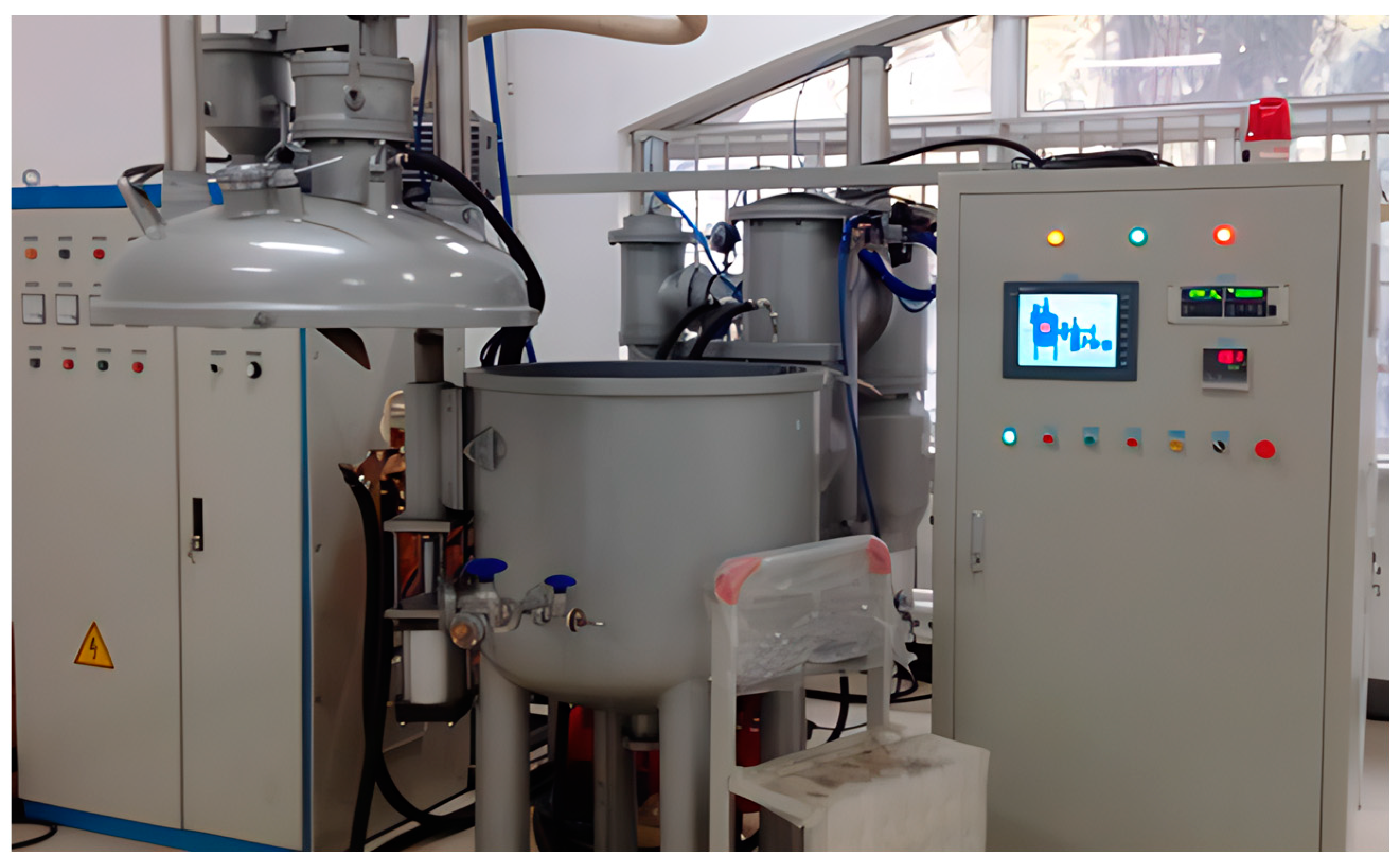

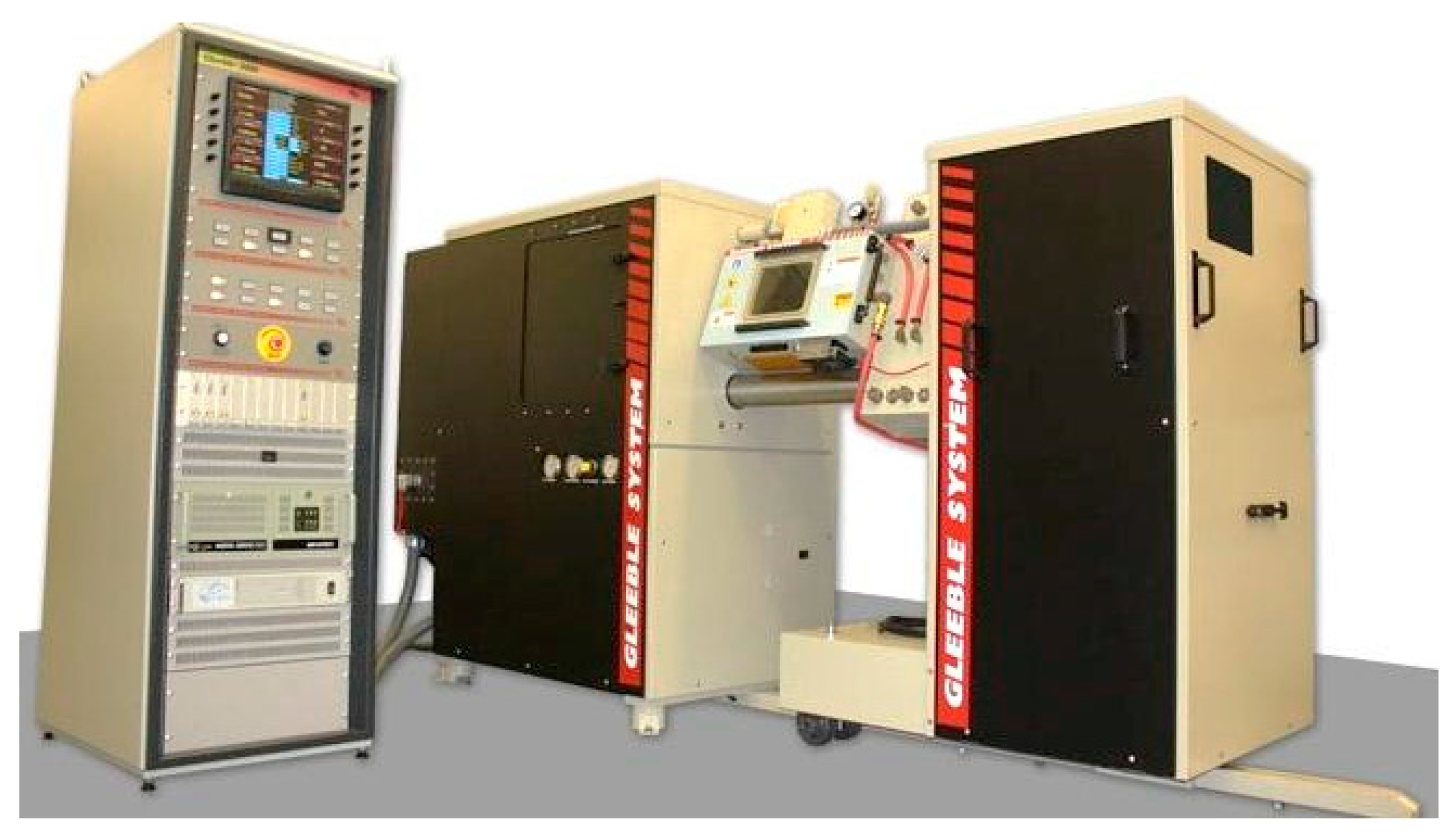
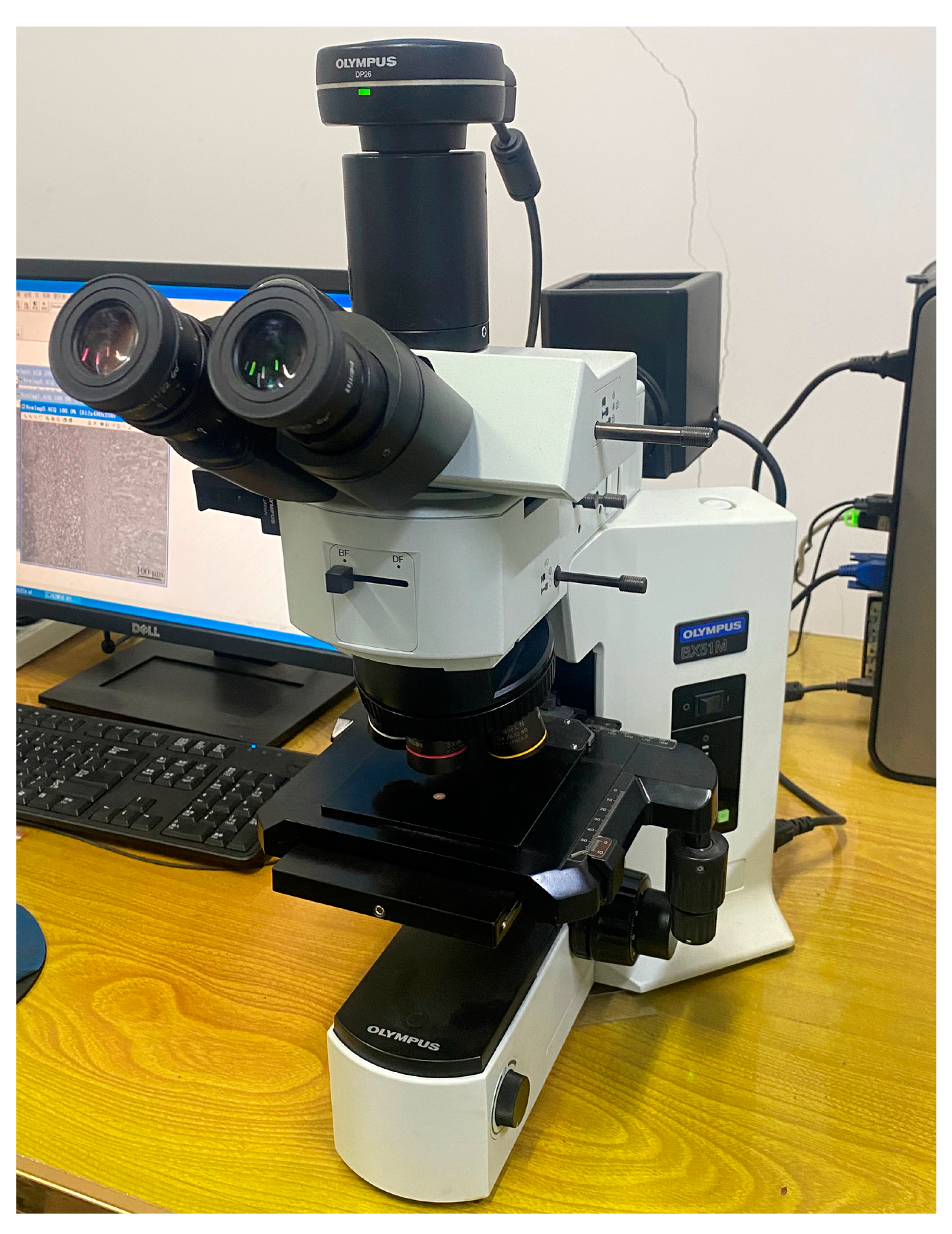
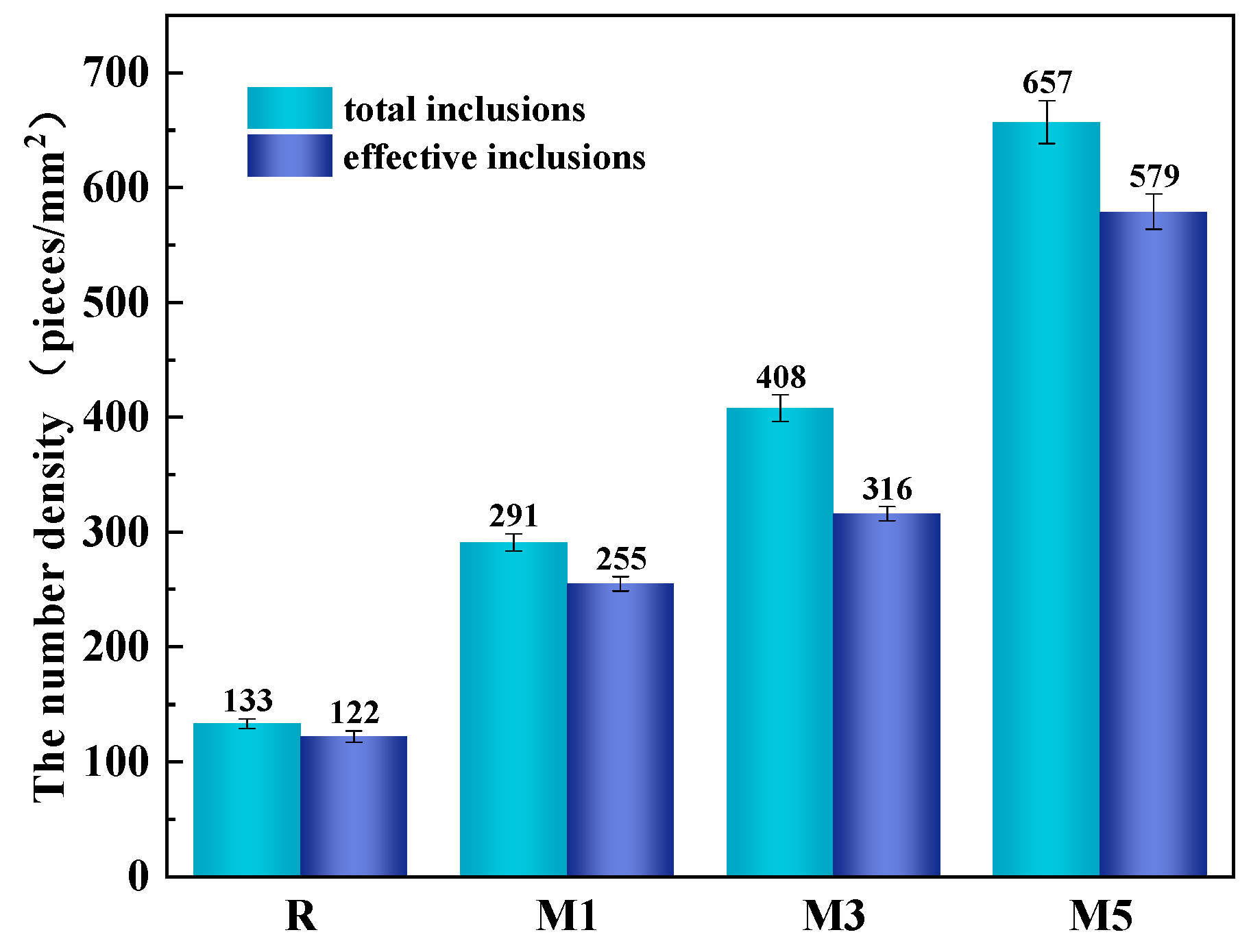

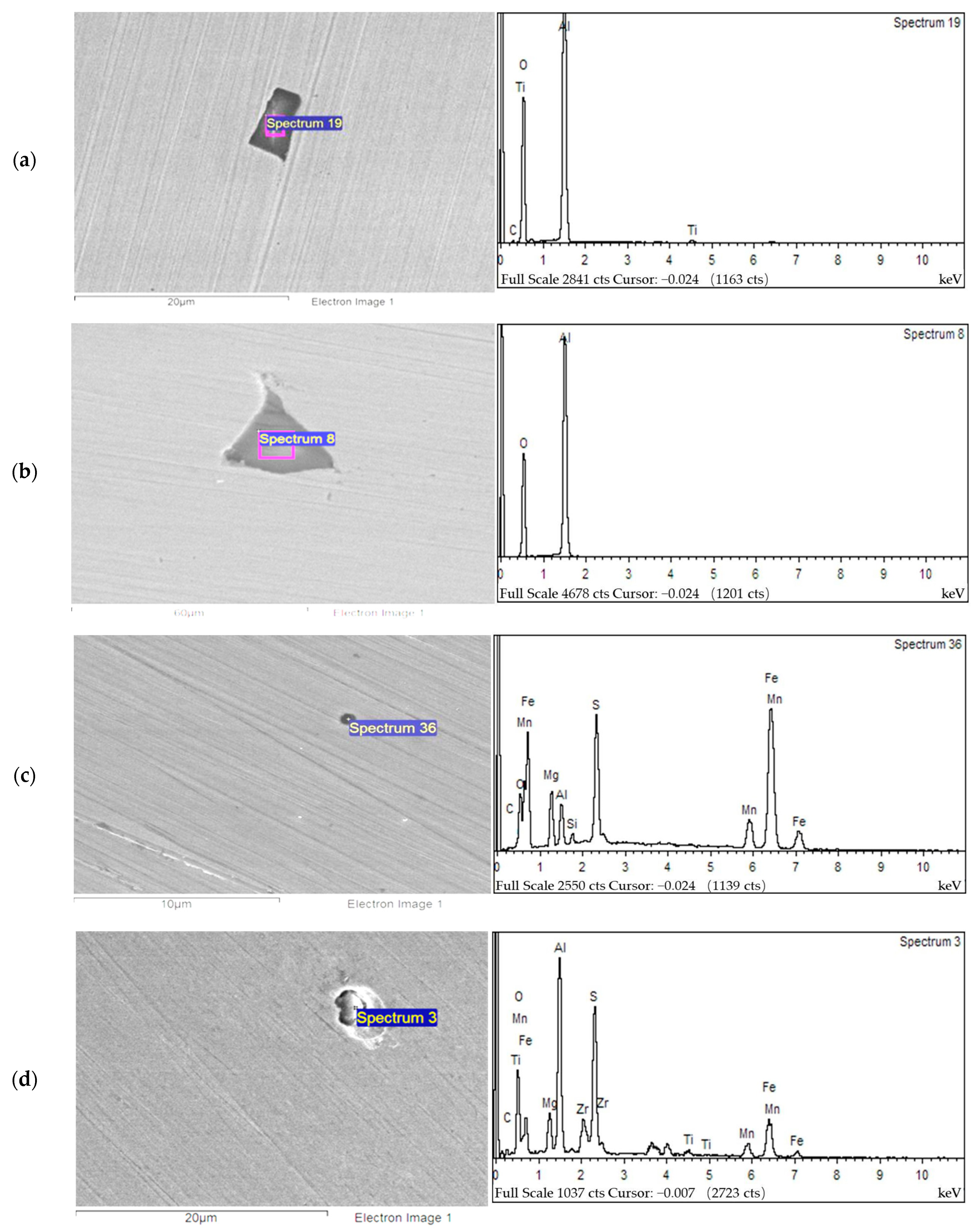

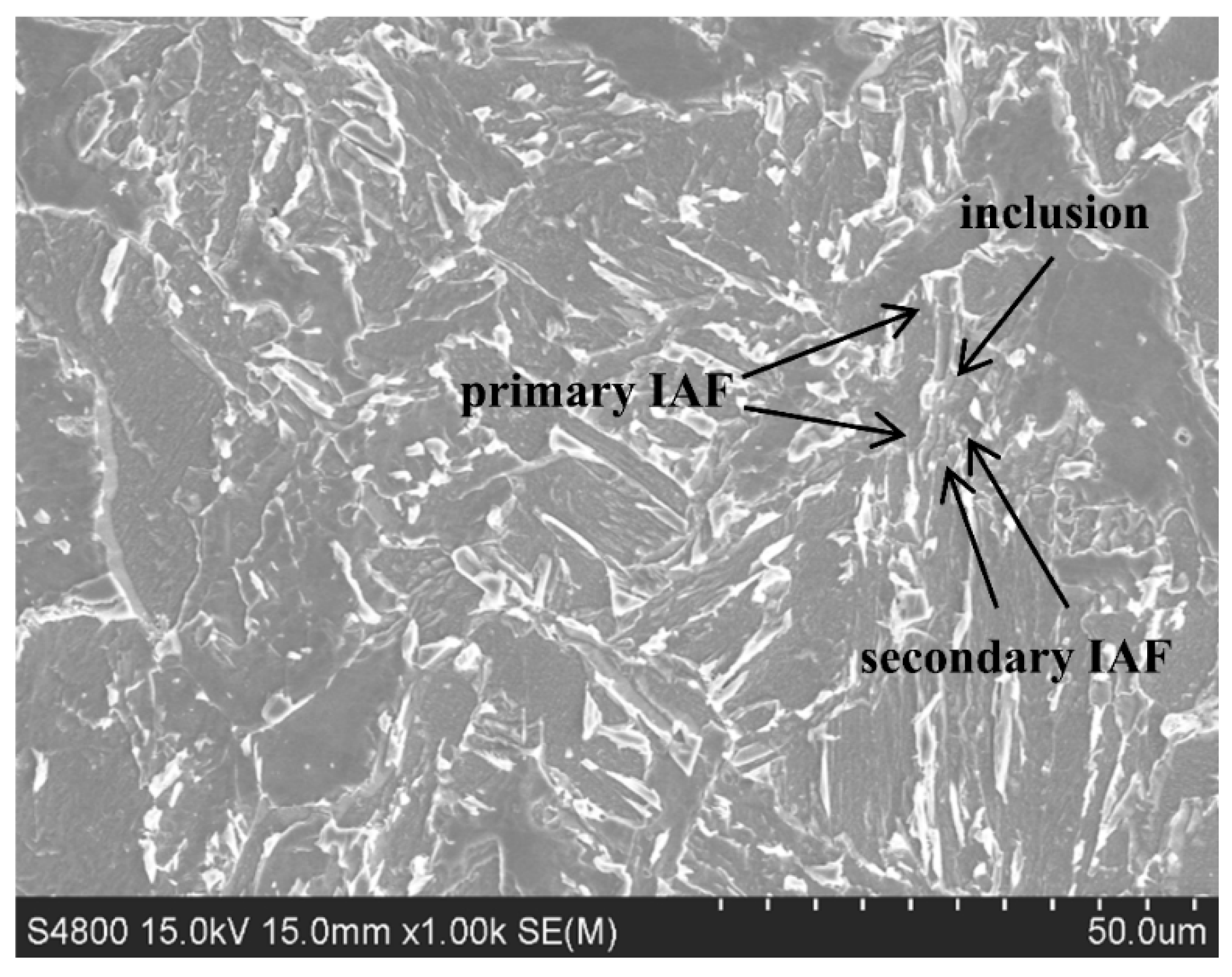

| Items | Chemical Compositions (wt.%) | ||||||||||||
|---|---|---|---|---|---|---|---|---|---|---|---|---|---|
| C | Si | Mn | P | S | Ni | Mo | V | Nb | Cr | Als | Ti | N | |
| Design compositions | 0.06–0.09 | 0.10–0.20 | 1.45–1.60 | ≤0.015 | ≤0.006 | 0.25–0.35 | 0.20–0.30 | 0.045–0.055 | 0.01–0.02 | 0.10–0.30 | ≤0.01 | 0.01–0.02 | ≤0.005 |
| Actual compositions | 0.10 | 0.13 | 1.4 | 0.012 | 0.005 | 0.28 | 0.202 | 0.047 | 0.015 | 0.19 | 0.007 | 0.016 | / |
| Items | R | M1 | M3 | M5 |
|---|---|---|---|---|
| Mg (wt.%) | 0 | 1 | 3 | 5 |
| Mg-Zr alloys (g) | 0 | 71.754 | 215.261 | 358.770 |
| Items | R | M1 | M3 | M5 | |
|---|---|---|---|---|---|
| Size (μm2) | |||||
| <0.5 | 68 | 116 | 171 | 242 | |
| 0.5–1.0 | 26 | 77 | 76 | 137 | |
| 1.0–2.0 | 12 | 44 | 33 | 82 | |
| 2.0–3.0 | 9 | 8 | 13 | 60 | |
| 3.0–5.0 | 7 | 10 | 23 | 58 | |
| 5.0–10.0 | 7 | 9 | 23 | 36 | |
| 10.0–20.0 | 2 | 22 | 37 | 24 | |
| >20 | 2 | 5 | 32 | 18 | |
| Inclusion | Lattice Constant/(10−8 cm) | Mismatch (%) | ||
|---|---|---|---|---|
| a | b | c | ||
| MnS | 5.224 | 5.224 | 5.224 | 8.8 |
| MgO | 4.216 | 4.216 | 4.216 | 2.8 |
| Substance | Austenite | MgO |
|---|---|---|
| Thermal expansion coefficient (10−6 K−1) | 23.2 | 13.8 |
| Position | S | Mn | Mg | Fe |
|---|---|---|---|---|
| 1 | 0.66 | 0.59 | 2.66 | 39.34 |
| 2 | 0.80 | 0.71 | 2.23 | 60.37 |
| 3 | 0.69 | 0.82 | 0.56 | 79.69 |
| 4 | - | 0.75 | - | 98.34 |
Disclaimer/Publisher’s Note: The statements, opinions and data contained in all publications are solely those of the individual author(s) and contributor(s) and not of MDPI and/or the editor(s). MDPI and/or the editor(s) disclaim responsibility for any injury to people or property resulting from any ideas, methods, instructions or products referred to in the content. |
© 2023 by the authors. Licensee MDPI, Basel, Switzerland. This article is an open access article distributed under the terms and conditions of the Creative Commons Attribution (CC BY) license (https://creativecommons.org/licenses/by/4.0/).
Share and Cite
Liu, Y.; Zhang, W.; Wang, K.; Du, A. Effect of Mg Addition on Inclusions in the Welding Heat-Affected Zone of Pressure Vessel Steels. Materials 2023, 16, 7369. https://doi.org/10.3390/ma16237369
Liu Y, Zhang W, Wang K, Du A. Effect of Mg Addition on Inclusions in the Welding Heat-Affected Zone of Pressure Vessel Steels. Materials. 2023; 16(23):7369. https://doi.org/10.3390/ma16237369
Chicago/Turabian StyleLiu, Yan, Wenguang Zhang, Kai Wang, and Anna Du. 2023. "Effect of Mg Addition on Inclusions in the Welding Heat-Affected Zone of Pressure Vessel Steels" Materials 16, no. 23: 7369. https://doi.org/10.3390/ma16237369
APA StyleLiu, Y., Zhang, W., Wang, K., & Du, A. (2023). Effect of Mg Addition on Inclusions in the Welding Heat-Affected Zone of Pressure Vessel Steels. Materials, 16(23), 7369. https://doi.org/10.3390/ma16237369






